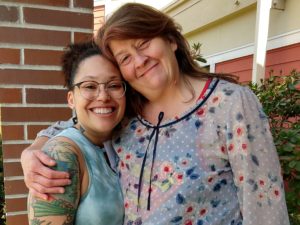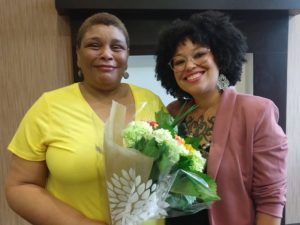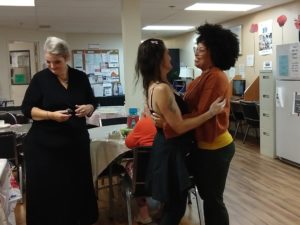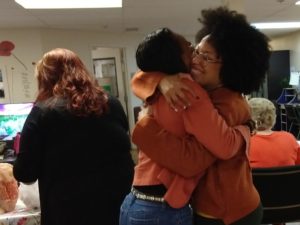06 Feb “I know their names. I know their stories. They are my family.”
Published February 2020
Shouts of “hello” greet Dietra as she walks into the Day Center. She stops by a table and asks a woman if she had a good night’s rest. Another woman hugs her, and Dietra tears up. They are not just clients but her friends and family. She knows their names and she knows their stories.
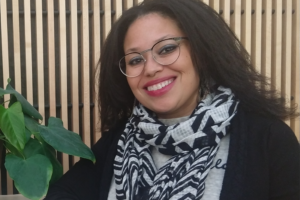 During her 17-year career, Dietra Clayton has worked along the length of care continuum – from in-home care to helping people with disabilities and those that were HIV positive, to psychiatric work. She came to The Sophia Way in 2017 for a part-time, on-call job and “fell in love with the organization and its work.” She wanted to be a case manager because she felt she could make a difference with her knowledge and experience in mental health and the legal system.
During her 17-year career, Dietra Clayton has worked along the length of care continuum – from in-home care to helping people with disabilities and those that were HIV positive, to psychiatric work. She came to The Sophia Way in 2017 for a part-time, on-call job and “fell in love with the organization and its work.” She wanted to be a case manager because she felt she could make a difference with her knowledge and experience in mental health and the legal system.
Dietra is currently Director of Client Services and Shelter Programs. In this in-depth interview, she talks to Sujata Agrawal about her work and the critical role that The Sophia Way plays in supporting women to journey out of homelessness.
Could you start by telling us what days at the shelter look like?
There are lovely days, and there are gray days.
A lovely day is when staff opens the doors of the Day Center in the morning, women from the Extended-Stay Shelter are in the community room rather than in their cubicles. Breakfast is laid out. We have three volunteers helping us. The women quietly go about their business and no one is grouchy. That is a magical day!
Gray days are when you have to help a woman get dressed because she is inebriated and walking around naked. Or another who is hallucinating and talking to the washers. Some days it does not take much to trigger an episode – someone taking a shower for too long sets off a woman awaiting her turn. But you know what? It’s okay to be angry or upset. With nearly 40 women interacting in close quarters, there are bound to be arguments and fights. Most incidents occur because of the trauma of experiencing homelessness. In such instances, our staff focuses on getting the woman to ask a staff member to intervene (respond) rather than shout (react).
What are the challenges to ending homelessness?
There are systemic issues – poverty, racism, lack of living wages, out of reach rents – that contribute to rising homelessness, and the disproportionate number of women of color who are homeless.
The big challenge is, of course, the lack of affordable housing. And affordable is not a one-bedroom for $1,800 on the Eastside. It is about paying rent not more than 30% of your income, and the sad reality is there is a severe shortage of low-income housing options.
Another issue is the increase in the number of elderly – I call it the silver tsunami – with no savings and living on social security. People who have held jobs receive approximately $1,200/month; people receiving disability payments from social security receive $735/month. That’s way too low to find any housing! People are on waitlists for 5-6 years or even longer!
An expectation is to get a woman into housing within three months, but that is hard. Our goal is to have them housed in six months, but that is not always possible. It is a process with many moving pieces, and it is time-consuming. Just getting a legal identification can take up to three months. Applying for and receiving disability support or other income they would qualify for can take years. Woman may need counseling or additional schooling to get a job. Our case managers focus on not just housing women, but ensuring that they stay housed, and that takes time.
The Sophia Way served 1,143 (unduplicated) women in 2019 and housed 83 women. Would you consider this a successful outcome?
As a perfectionist, I tend not to settle for anything less than 100%. However, knowing the systemic issues, the number of housing units available, that the lack of adequate rapid rehousing and diversion funds, also makes me realize that 100% success is not realistic.
Also – and I cannot emphasize this enough – the number of women housed does not tell the whole story of all that we do to support them. Many things need to be in place before some women can even apply for housing like getting missing documents. We also help in setting them up with an attorney, getting out of debt, erasing their medical debt, helping to access treatment. Every woman leaves Sophia’s Place with something. And every woman who has been through our programs (housed or unhoused), has talked about how loved they feel. That, for us, is success.
You cannot quantify some things. There was a woman who was on and off drugs for eight years before she came to Sophia’s Place. We got her into a treatment program, and she has been sober since (nine months). When I see her at the Day Center, she tells me, “Hey, you can be proud of me, I am still sober.” She’s still homeless but staying strong to maintain her sobriety. Her courage is unquantifiable.
The other aspect is the sense of community at Sophia’s Place – the women take care of each other—even though they have so much going on in their own lives. They notice when friends are being riled and talk them down. They escort friends on the bus to the Emergency Shelter to make sure they are safe.
When our donors, visiting the Day Center, see this feeling of community, they realize their return on investment is much more than monetary – generating millions of smiles!
A common myth is that people who are homeless are addicts — your thoughts.
Many times addiction is the outcome of homelessness, not the cause of it. Alcohol or drugs are usually secondary to what is going on with you emotionally. It could start with self-medication because it makes you feel better, but then it escalates. If you are living well, have an apartment and a decent job, a glass of wine with dinner is fun. But when you are cold, living in your car, jobless, just a glass of wine is not enough to numb the pain of what you are going through. You do whatever makes it easier to live through the days and nights, which can result in a downward spiral. For people experiencing homelessness, it is the emotional trauma and pain, the struggle to survive that can lead to addiction. They need help.
What do people who live in houses fail to understand about those without a home?
I would say there is a lack of understanding of how and why people who are experiencing homelessness got there, why they continue to be homeless, and the problems they face every day. People need to be aware of and understand the systemic societal issues that cause and perpetuate homelessness.
There is also the immense trauma that comes with the words “being homeless” versus “experiencing homelessness.” When you say, “being homeless,” you define the person – that is who you are, that is how I am going to treat you, that is how I am going to look at you. No one wants to feel like that.
Also, have empathy – it is a 24/7 job to survive homelessness.
What can one do to help when they see someone who is experiencing homeless?
It is hard to see so many beautiful souls suffering – and there are many things you can do to support them. Treat them with dignity. Give them the same respect you would give to any other person you meet. Offer encouragement: “How are you doing?” “Hey, I hope you make it.” Ask what they need. Always try to have something in your bag or car that you can give them (perhaps an aluminum blanket, socks, some snacks, a $5 gift card). And most importantly, reach out to agencies and organizations that are doing the work – support them by donating and volunteering.
Tell us how the staff is supported in their work.
We have instituted best practices and focused on training. All staff is now cross-trained across all programs and have a mandatory 40 hours of training annually. Trauma-informed care is a huge chunk of that. Learning and understanding what it is like to experience homelessness, what it feels like to suffer from dementia, what it means not to have a safe place, how to obtain supports to prevent sliding back into homelessness. Our staff receives training and tools to recognize and understand the issues they need to manage.
Our monthly meetings give us the chance to talk about staff needs and fill gaps in training. Homelessness is not just what you see; the most important part is what you don’t see. There are people with a master’s degree who may appear psychotic, but are not. They are simply having a hard time coping with their situation, and that makes them scared.Our shelter staff and case managers work day and night to support the women. They are truly amazing!
Despite all the trauma you see every day, what is it that makes you get up in the morning and want to go to work?
You have to work at it relentlessly. You listen to the woman sitting in front of you, talking about her trauma. And you know she’s not the only one, there are 20 more with the same stories or worse. You focus on helping that first woman and just keep going.
My family has always been passionate about social justice – my grandma ran an organization to end hunger in Boise and worked for Headstart – and I learned from an early age about the many systemic issues that needed illumination.
The driving force, though, has been my sister. She has cerebral palsy and epilepsy, is wheelchair-bound and has a mental age of two. Seeing someone born without has made me appreciative of my cognitive abilities. I want to help people who are in different and difficult situations. I want to give our women something beautiful every day, even if it’s a smile or words of encouragement. Life is filled with beautiful and horrible moments, and we all need someone to lean on.
What are you looking forward to this year?
The new shelter!
I have dreams of a place that offers all the support services that women need, including an on-site nurse practitioner, mental therapy support, a foot care specialist, even a dietician. The place would have two kinds of housing – truly affordable, and the other a low-barrier-harm-reduction housing for people with mental health issues who do not want to be medicated. For my dream to come true, we need lots of funding!
The shelter is the beginning of that dream. I visited the construction site last week. It is going to be a beautiful building with amazing views. I am very excited about the new shelter because it will offer women so much more than what we can give at the moment. It will allow us to help many chronically homeless women at the Emergency Shelter break through their barriers. It will give them 24/7 shelter, care, and comfort.
Dietra with some of her family
Dietra with some of the staff during the holidays


